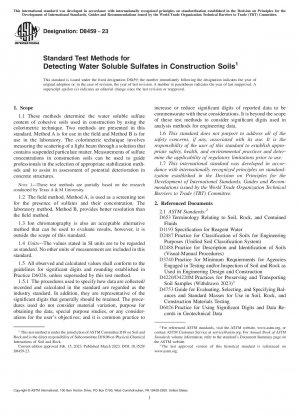ASTM D8459-23
Standard Test Methods for Detecting Water Soluble Sulfates in Construction Soils
- Standard No.
- ASTM D8459-23
- Release Date
- 2023
- Published By
- American Society for Testing and Materials (ASTM)
- Latest
- ASTM D8459-23
- Scope
- 1.1 These methods determine the water soluble sulfate content of cohesive soils used in construction by using the colorimetric technique. Two methods are presented in this standard. Method A is for use in the field and Method B is for use in the laboratory. The colorimetric technique involves measuring the scattering of a light beam through a solution that contains suspended particulate matter. Measurements of sulfate concentrations in construction soils can be used to guide professionals in the selection of appropriate stabilization methods and to assist in assessment of potential deterioration in concrete structures. NOTE 1—These test methods are partially based on the research conducted by Texas A & M University. 1.2 The field method, Method A, is used as a screening test for the presence of sulfates and their concentration. The laboratory method, Method B, provides better resolution than the field method. 1.3 Ion chromatography is also an acceptable alternative method that can be used to evaluate results, however, it is outside the scope of this standard. 1.4 Units—The values stated in SI units are to be regarded as standard. No other units of measurement are included in this standard. 1.5 All observed and calculated values shall conform to the guidelines for significant digits and rounding established in Practice D6026, unless superseded by this test method. 1.5.1 The procedures used to specify how data are collected/ recorded and calculated in the standard are regarded as the industry standard. In addition, they are representative of the significant digits that generally should be retained. The procedures used do not consider material variation, purpose for obtaining the data, special purpose studies, or any considerations for the user’s objectives; and it is common practice to increase or reduce significant digits of reported data to be commensurate with these considerations. It is beyond the scope of these test methods to consider significant digits used in analysis methods for engineering data. 1.6 This standard does not purport to address all of the safety concerns, if any, associated with its use. It is the responsibility of the user of this standard to establish appropriate safety, health, and environmental practices and determine the applicability of regulatory limitations prior to use. 1.7 This international standard was developed in accordance with internationally recognized principles on standardization established in the Decision on Principles for the Development of International Standards, Guides and Recommendations issued by the World Trade Organization Technical Barriers to Trade (TBT) Committee.
ASTM D8459-23 Referenced Document
- ASTM D1193 Standard Specification for Reagent Water
- ASTM D2487 Standard Test Method for Classification Of Soils For Engineering Purposes
- ASTM D2488 Recommended Practice for Description Of Soils (Visual-Manual Procedure)
- ASTM D3740 Standard Practice for Minimum Requirements for Agencies Engaged in the Testing and/or Inspection of Soil and Rock as Used in Engineering Design and Construction
- ASTM D4220/D4220M Standard Practices for Preserving and Transporting Soil Samples*, 2024-04-22 Update
- ASTM D4753 Standard Specification for Evaluating, Selecting, and Specifying Balances and Scales for Use in Soil, Rock, and Construction Materials Testing
- ASTM D6026 Standard Practice for Using Significant Digits in Geotechnical Data
- ASTM D653 Standard Terminology Relating to Soil, Rock, and Contained Fluids
ASTM D8459-23 history
- 2023 ASTM D8459-23 Standard Test Methods for Detecting Water Soluble Sulfates in Construction Soils
